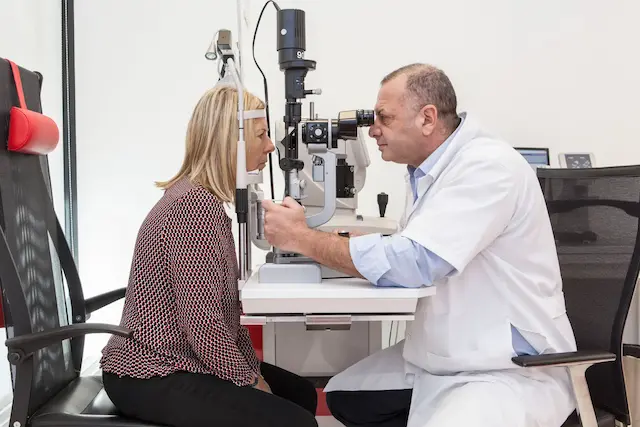
PresbyMax Monovision
Revolutionary technology for treating presbyopia without contact
Thanks to technological advances, refractive surgery now allows for permanent correction of visual defects.
PresbyMax Monovision offers an effective solution for treating presbyopia, a natural age-related phenomenon that causes a decrease in near vision.

Presbyopia: a natural evolution of the eye
From the age of 40, near vision begins to decline significantly. This phenomenon, which affects almost the entire population, is not a disease, but a normal consequence of ocular aging.
By losing its flexibility and accommodation capacity, the crystalline lens no longer allows light rays to converge correctly on the retina, making focusing difficult, especially for near vision.
Result? Blurred vision, increased visual fatigue and sometimes headaches.
To compensate for this loss of sharpness, traditional solutions include reading glasses or contact lenses. However, a more durable and efficient alternative exists: PresbyMax Monovision refractive surgery.

PresbyMax Monovision treatment profile showing correction zones
PresbyMax Monovision: cutting-edge technology
PresbyMax Monovision is innovative software that treats presbyopia using the same lasers employed to correct myopia. This quick and painless procedure lasts only a few minutes and requires no direct contact with the eye.
Thanks to ultra-precise laser pulses, the cornea is reshaped to create multiple vision zones, thus simulating the effect of multifocal lenses.
- Near vision is improved by sculpting the central zone of the cornea.
- Distance vision is optimized by reshaping the periphery.
This process allows patients to regain excellent vision at all distances with improved depth of field. Moreover, visual acuity improves rapidly after the procedure, particularly for near vision. Developed by SCHWIND, a leader in ophthalmic technologies, the PresbyMax method relies on high-precision lasers (SCHWIND AMARIS) guaranteeing optimal results in record time.
Who can benefit from this surgery?
If you want to get rid of your glasses or contact lenses, presbyopia surgery is an option to consider. In general, all presbyopic patients can be operated on, subject to a favorable preoperative assessment.
The ophthalmologist performs several examinations to verify the patient's eligibility:
- Keratometry: measurement of corneal curvature to detect any abnormalities (such as keratoconus).
- Pachymetry: measurement of corneal thickness, essential for laser treatment.
- Corneal topography: detailed analysis of the corneal surface to exclude any contraindications.
Advantages of PresbyMax Monovision
- Quick procedure: correction is performed in just a few minutes.
- Express recovery: near vision improves very quickly.
- Simultaneous correction of other disorders: myopia, hyperopia and astigmatism can be treated at the same time.
- High precision and comfort: advanced technology ensuring optimal results. Operated patients are generally very satisfied, highlighting the gentleness of the procedure and the effectiveness of clinical results.
Although Presbymax SmartSurfACE is the fastest, safest and least invasive technique for correcting vision defects, it is not the only existing technique.
Comparison of existing laser techniques:
Supracor Teneo-lasik (BAUSCH+LOMB)
-
Procedure
2 steps:
1. Cutting of the epithelium by Femtosecond laser (Femtolasik) or manual (Lasik)
2. Corneal ablation by Excimer laser
-
Duration (per eye)
about 15 minutes -
Recovery time
2 weeks -
Explanatory video

Presbyond - lasik (ZEISS)
-
Procedure
2 steps:
1. Cutting of the epithelium by Femtosecond laser (Femtolasik) or manual (Lasik)
2. Corneal ablation by Excimer laser
-
Duration (per eye)
about 15 minutes -
Recovery time
2 weeks -
Explanatory video

Presbymax SmartSurface (SCHWIND)
-
Procedure
1 step:
Photoablation by sublimation of epithelium and cornea.
-
Duration (per eye)
20 - 30 seconds -
Recovery time
2 weeks -
Explanatory video

2 steps:
1. Cutting of the epithelium by Femtosecond laser (Femtolasik) or manual (Lasik)
2. Corneal ablation by Excimer laser
2 steps:
1. Cutting of the epithelium by Femtosecond laser (Femtolasik) or manual (Lasik)
2. Corneal ablation by Excimer laser
1 step:
Photoablation by sublimation of epithelium and cornea.
Prelex (Presbyopic Lens Exchange)
There is also a surgical technique to correct presbyopia: Prelex (Presbyopic Lens Exchange). This technique involves replacing the eye's natural crystalline lens with a multifocal or accommodative intraocular lens, thus allowing clear vision at different distances.
Prelex (Presbyopic Lens Exchange)
Procedure
2- Implantation of multifocal intraocular lens (IOL) The intraocular lens allows correction of presbyopia and other refractive errors, providing sharp vision at different distances.
Duration (per eye)
2- Implantation of multifocal intraocular lens (IOL) The intraocular lens allows correction of presbyopia and other refractive errors, providing sharp vision at different distances.
Limitations and precautions
Eligibility to be verified
A thorough medical evaluation is essential to ensure that no contraindications exist.
Occasional wearing of glasses
Although vision is corrected, glasses may be necessary in low light conditions.
Minimal but existing risks
Like any procedure, refractive surgery can cause rare side effects.
During the procedure
The procedure lasts between 10 and 15 minutes and follows these steps:
Application of anesthetic eye drops to ensure total comfort.
Installation under the laser microscope, placement of an eyelid retractor to prevent any blinking.
The laser removes the thin superficial layer of the cornea without incision.
The laser corrects your vision in 30 seconds per eye.
A bandage contact lens is placed on the eye and promotes healing for 4 days.
After the operation
In the hours following the procedure, it is normal to experience:
- Stinging or slight irritation.
- Temporary blurred vision (fog effect).
- Tearing and light sensitivity.
These symptoms disappear quickly. A post-operative treatment is prescribed to accelerate recovery and limit discomfort.
When do we regain optimal vision?
1 week after: possible resumption of daily activities, including work.
3 to 4 weeks after: progressive improvement of vision.
3 months after: completely stabilized vision.